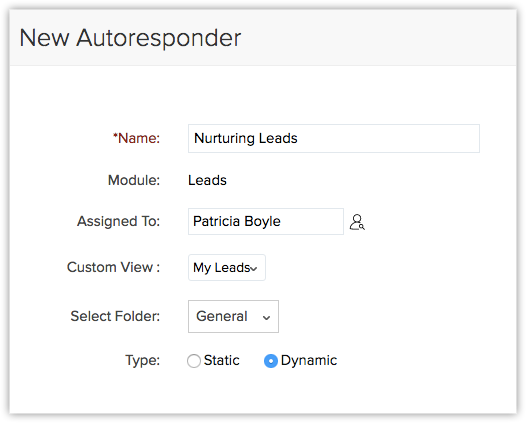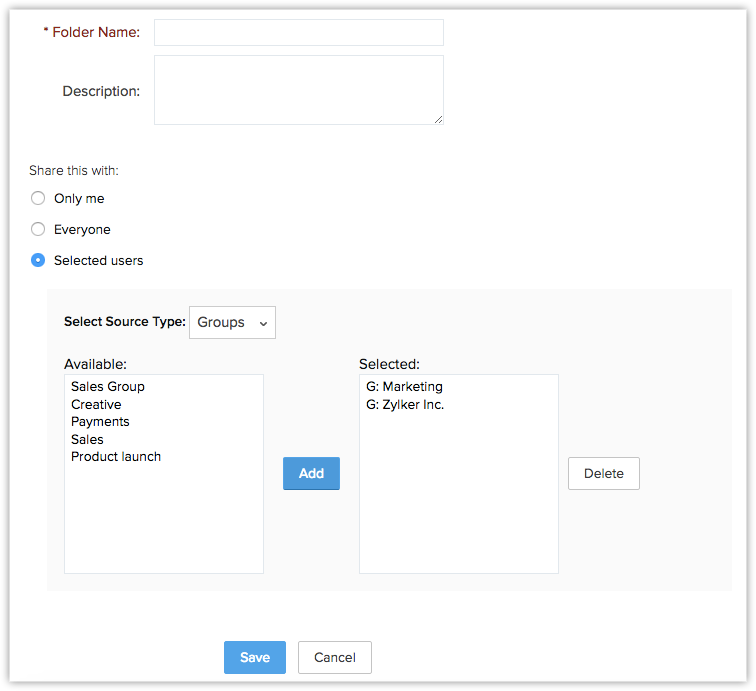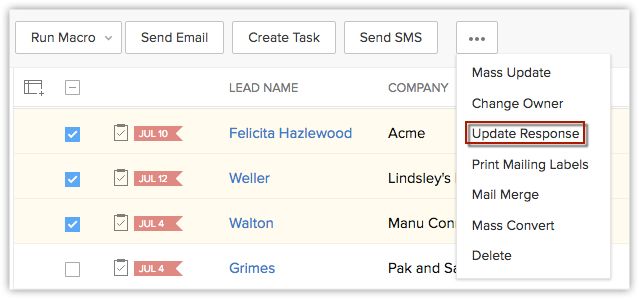Managing Autoresponders
Managing Autoresponders
Important:
- This feature is available only for the Leads and Contacts module.
- You can set a maximum of 3 autoresponders and a maximum of 5 follow-ups per autoresponder.
- You can send autoresponder emails as a part of mass emails also. The number of mass emails that can be sent per day per organisation will vary according to your subscription.
- Custom view selected for the autoresponder must contain new data. If you select a custom view in which data is not new, autoresponder will send the first email to the same old data during subsequent iterations. For example, you can select custom views "Today's Leads" and "New This Week Contacts" instead of "All Open Leads" and "Recently Created Leads". In the Today's Leads view, data is always updated with the today's data whereas the data in All Open Leads view may not change frequently.
- While setting up Dynamic type Autoresponders, always select the Custom Views according to the options in the Recurrence Pattern section. If you set the recurrence pattern as By Day, make sure your data in the selected custom view is new every day. Similarly if you select By Week, your data must be a new one for that week before the autoresponder is initiated. If the data used is old, autoresponder will send the first email to the same data during subsequent iterations.
- While executing the autoresponder, system cannot identify the duplicate records. Hence, you are recommended to check for the duplicate contacts and merge with the primary record, before setting up the autoresponder.
- At present, you cannot track the response when customer responds to your email. Hence, you have to manually select the contacts from the mailing list to exclude them from the next follow-up.
- Use the unsubscribe form in the autoresponder email templates. By using unsubscribe form, you can allow the recipients to opt out from your next follow-up and avoid Anti-SPAM complaints.
To set up autoresponders
- Click the Leads/Contacts tab.
- In the Leads/Contacts Home page, click More Actions
 > Autoresponders.
> Autoresponders. - In the Autoresponders page, click Create Autoresponder.
- In the New Autoresponder page, do the following:
- Enter the Name of the autoresponder.

- Enter the Name of the autoresponder.
- Select the owner of the records from the Assigned To pick list.
By default, the field displays the name of the user who creates the autoresponder. - Select the Custom View to set up the recipient list for the autoresponder.
- Select a Folder for the autoresponder.
- Select Static or Dynamic and specify the corresponding details. (Refer the table for the list of standard fields)
- Static- Autoresponder in which the Follow-up happens on a fixed date.
- Dynamic - Autoresponder in which the Follow-up happens on predefined intervals set by you.
- Static- Autoresponder in which the Follow-up happens on a fixed date.
- You can add follow-ups if needed. After selecting the email template in the follow-up, you will be prompted to enter the From and Reply to email addresses.
Here you can choose your account email address, email address of the record owner and the organisation email form the drop-down list. - Click Save.

- The autoresponder email will not be sent to the records for which the Email Opt Out is enabled.
- Only when you clear the Email Opt Out check box in the Record's Details page, the autoresponder emails will be sent to those records.
- If you choose an individual email address in the from field, then in the address in the reply to field has to be an organisation email address.
If you choose organisation email address in the from field, then in the address in the reply to field has to be an individual email address.
The following table gives the list of fields and their description when Static option is selected.
| Fields | Description |
| Follow-up Date | Specify the follow-up date. The follow-up date is calculated with respect to the day when the autoresponder is initiated. |
| Email template | Choose the template from the drop-down list. |
The following table gives the list of fields and their description when Dynamic option is selected.
| By Day - Fields | Description |
| Recur every ___ day(s) | Enter how often in days the autoresponder should be repeated. |
| Recur everyday | Select this if the autoresponder should be repeated everyday. Select the Start date (MM/dd/yyyy format) and time for the autoresponder. |
| End by | Select the End date for the autoresponder in MM/dd/yyyy format. |
| No end date | Select this if the autoresponder should continue repeating till you specify an end date. |
| Choose Email Template | Choose the template from the drop-down list. |
| Add Follow-up | Click the link to add follow-ups for the autoresponder. Example: The autoresponder is initiated on 01-01-2010 and the follow-up dates specified are After 3 days and After 10 days. In such a case, the first follow-up email will be sent on 04-01-2010 and the second follow-up email will be sent on 11-01-2010. |
| By Week - Fields | Description |
| Recur every ____week(s) on S-M-T-W-T-F-S | Enter how often in weeks the autoresponder should be repeated. Then, select the checkbox(es) that correspond to the day(s) of the week on which the recurrence should occur. |
| Start by | Select the Start date (MM/dd/yyyy format) and time for the autoresponder. |
| End by | Select the End date for the autoresponder in MM/dd/yyyy format. |
| No end date | Select this if the autoresponder should continue repeating till you specify an end date. |
| Choose Email Template | Choose an email template for the autoresponder from the drop-down list. |
| Add Follow-up | Click the link to add follow-ups for the autoresponder. Example: The autoresponder is initiated on 01-01-2010 and the follow-up dates specified are After 3 days and After 10 days. In such a case, the first follow-up email will be sent on 04-01-2010 and the second follow-up email will be sent on 11-01-2010. |
| By Month - Fields | Description |
| Day __ of every ___ month(s) | Enter how often in months and on the specified date the autoresponder should be repeated. |
| ____ ____ of every month | Select a particular day when the autoresponder should be repeated every month. |
| Start by | Select the Start date (MM/dd/yyyy format) and time for the autoresponder. |
| End by | Select the End date for the autoresponder in MM/dd/yyyy format. |
| Choose Email Template | Choose an email template for the autoresponder from the drop-down list. |
| Add Follow-up | Click the link to add follow-ups for the autoresponder. Example: The autoresponder is initiated on 01-01-2010 and the follow-up dates specified are After 3 days and After 10 days. In such a case, the first follow-up email will be sent on 04-01-2010 and the second follow-up email will be sent on 11-01-2010. |
Create Folders
In the CRM, you can create various folders for a better organisation of your autoresponders. This helps you to keep them classified under different categories for quick access.
To create folders
- Click the Leads/Contacts tab.
- In the Leads/Contacts Home page, click More Actions
 > Autoresponders.
> Autoresponders. - In the Autoresponders page, click Create Folder.
- In the Create Folder page, do the following:
- Enter the Folder Name.
- Enter the Description.
- Specify the accessibility to the autoresponder feature.

- Enter the Folder Name.
- Click Save.
Excluding Contacts from Follow-up
After receiving replies from the recipients, you can exclude the leads or contacts from the follow-up, and schedule the next follow-up only to the leads/contacts that have not responded.
To exclude records from the next follow-up
- Click the Leads/Contacts tab.
- In the Leads/ContactsHome page, click More Actions
 > Autoresponders.
> Autoresponders. - In the Autoresponders page, click the Update Response link corresponding to the autoresponder.
- In the Mail Sent List overlay, select the leads/contacts to be excluded from the next follow-up.
- Click Update Response.
Note that the Update Response option is available only for the Dynamic type autoresponders.
To exclude records before the autoresponder is initiated
The Mailing List will be available only after the autoresponder is initiated. In case you want to exclude some contacts from the mailing list, even before the autoresponder is initiated, follow the steps given below:
- Click the Leads or Contacts tab.
- In the Leads/Contacts Home page, select the check box(es) corresponding to the records that you want to exclude.
- Click More Actions
 > Update Response.
> Update Response.
- In the Select Autoresponder popup window, select the autoresponder from the drop-down list.
- Click Save.
Including all Contacts in the Follow-up
This option enables you to include all the contacts for the follow-up that you had excluded from the mailing list.
To include all the record for the next follow-up
- Click the Leads/Contacts tab.
- In the Leads/ContactsHome page, click More Actions
 > Autoresponders.
> Autoresponders. - In the Autoresponders page, click the Reset link corresponding to the autoresponder.
Related Articles
Managing Groups - An Introduction
Managing Groups - An Introduction In the CRM, you can create different types of groups (set of users) to manage a set of common records. Groups can be used for setting up team selling, team support, event management by a group of marketing users, ...Managing Multiple Currencies
Managing Multiple Currencies Benefits Terminologies Important Notes The multi-currency support in the CRM helps you to handle business transactions in the global marketplace easily. If you regularly deal with international clients and vendors, then ...Managing Web Tabs
Managing Web Tabs Activate Web Tabs Create web tabs Access Creator applications in the CRM Delete Web Tabs Web tabs help you to open web pages like company-wide announcements, web applications, etc. inside the CRM. All the the CRM users across the ...Managing Profile Permissions
Managing Profile Permissions List of Permissions Delete Profile To make the process of managing profile permissions easier, the permissions have been grouped in such a way that you will have no problem in customising them as needed. You can enable or ...Managing CRM Account Settings
Managing CRM Account Setting Change Personal Information Add Social Information Change Locale Information Change Name Format & Preferences Use Signature Once you sign up for the CRM and have your own account, you can personalise your CRM account. ...